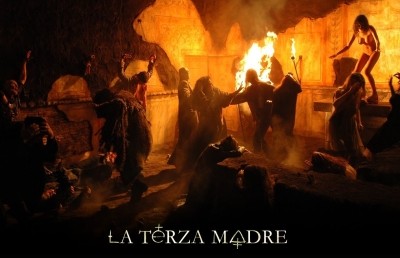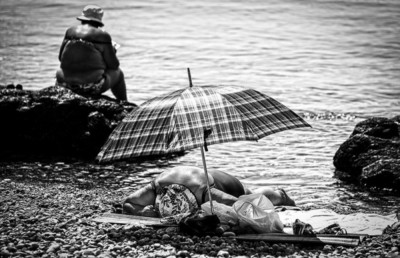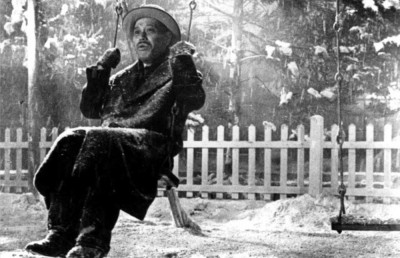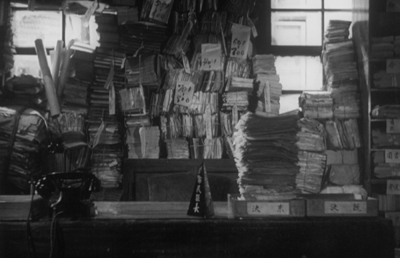Reanimating the Living Dead
Uncovering the Zombie Archetype in the Works of George A. Romero
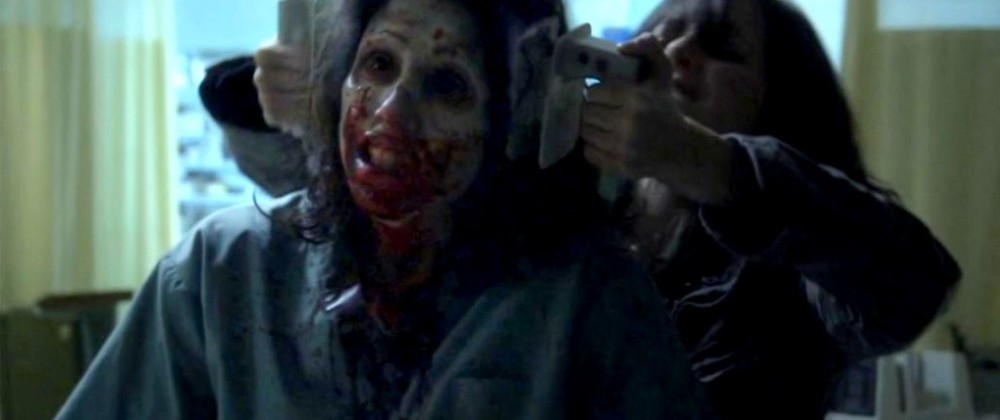
“And suddenly he thought, I’m the abnormal one now. Normalcy was a majority concept, the standard of many and not the standard of just one man … Full circle, he thought while the final lethargy crept into his limbs. Full circle.” (I am Legend, Richard Matheson 159)
Even for those who have never seen a zombie horror film, the mere mention of the subgenre conjures distinct images of mindless cadavers preying upon the flesh of the living, vulnerable only to serious head trauma. Such an interpretation, while not necessarily absolute, has emerged in the collective consciousness of the modern world in the wake of countless films subscribing to such an ideal. Yet this definition is distinctly inconsistent with the cultural origins of the zombie mythos, standing in stark contrast to the subservient reanimated drones rooted in Voodoo folklore. In actuality, the zombie as we understand it today is the direct result of auteur George Romero’s reimagining of the zombie identity. Beginning with his seminal Night of the Living Dead (1968) and continuing through to his most recent installment, Diary of the Dead (2007), Romero has purged the zombie genre of its culturally phobic roots and redefined it as a means of reflexive social commentary, subverting conventions within the genre both preceding and following his immense influence.
This essay will endeavour to explore the evolution of the zombie conception from its religious genesis through to its modern reinterpretation. First to be examined are the roots of zombie mythology in Afro-Caribbean Voodoo and their (mis)translation to American/European society, particularly through the influence of the horror classic White Zombie (Victor Halperin, 1932). Proceeding onward, I intend to establish the cinematic and sociological context of Night of the Living Dead’s release within the dissolution of the zombie subgenre and the expansion of American consciousness to the graphic and senseless violence present both in Vietnam and on the home front. Night’s prolific sequel, Dawn of the Dead (1978), will then be addressed as a furtherance of Romero’s revision and the refinement of his social discourse. The direct influence of both his ontological restructuring of the zombie creature and emphasis on social reflection will then be noted in the preservation and progression of the undead archetype in modern reimaginings such as Danny Boyle’s 28 Days Later (2002) and Zack Snyder’s remake of Dawn of the Dead (2004). Finally, Romero’s culmination of the Dead trilogy, Diary of the Dead, will be discussed as both a return to form and an alternative subversion of the 21st century zombie standard, defining the perennial quality of the auteur’s enduring vision and adaptability to transforming social currents.
Before addressing Romero’s work itself, it is necessary to understand that the zombie first originated in quite a different form than how it has been popularized in modern media, but that there still remain similarities in structure between the pre and post-Romero ghoul. Preceding the notion of the zombie as it was derived from voodoo demonology, the notion of the living dead is present in the very foundation of human psychology. Ghosts, vampires, and golems all find their roots in ancient folklore, and Bishop correlates this to Freud’s statement that “…to many people the acme of the uncanny is represented by anything to do with death, dead bodies, revenants, spirits and ghosts” (Bishop 200). Therefore the living dead, as with most fantastic archetypes of horror, is inevitably tied to the concept of the Uncanny, or the familiar rendered strange.
This idea is the direct result of the universal consciousness of human mortality and the fear involved in seeing those who were once alive (familiar) as an intersection of matter and spirit converted to death (unfamiliar), or pure matter devoid of what the ancient Greeks best described as Nous, roughly translated into “mind” or “soul,” but ultimately referring to that which animates objects.1 The uncanny nature of death stirs our fear of mortality, but when related to the living dead the uncanny matures into collective terror. Death, while frightening, is inevitable and can be accepted and thus made familiar. But the idea of an inanimate corpse revived into a form alien to its prior living state furthers the process of the unfamiliar into that which cannot be reconciled with natural laws. Hence, as seen in virtually any zombie film where a character must confront the reanimated corpse of a former friend or relative, the moment is often reserved for the climax or a significant plot point to magnify the relationship between the living and the undead. This is why Barbara finally succumbs to the ghoulish horde in Night when she sees her own zombified brother (1:25:45 – 1:26:05), or why “Helen Cooper does little more than allow herself to be butchered” (Bishop 203) when she finds her own daughter undead (1:24:30 – 1:25:25). Both women are unable to fight back because they are literally incapacitated by fear.
The function of the uncanny as the natural cause of fear toward the undead is universally human, but is not explicit to the zombie genre itself. In fact, the historical heritage of the proto-zombie stems from more social and ethnic anxieties revolving around the Afro-Caribbean community in the West Indies at the turn of the 20th century. Brought to the new world from Africa, stigmas of the primitiveness and primordial spirituality of the “dark” continent were transposed upon the same communities in the primarily African island of Haiti (Rhodes 70). With Haiti’s independence in 1804, the predominantly black nation ruled by Afro-Haitians became a source of anxiety for the American Southern Confederacy, who became increasingly fearful of their own slaves (Rhodes 70). Thus, the grounds for suspicion and fear of the Afro-Caribbean “Other” was set to erupt into misappropriation of Voodoo ritual through pejorative reports on Voodoo practice and William Seabrook’s (mis)anthropological book The Magic Island (1929), with its accusations of infanticide and cannibalism (Rhodes 72).
Due to the mélange of fact and fiction in reports on Voodoo practice, it is easy to see why there is no clear origin of the zombie concept. Rhodes states that the term had various spellings and various meanings throughout history, referring to the snake god “Zombi,” revenant spirits, and a pharmacological ingredient used in potions (75). Indeed, the etymology of the term is most likely found in the Kimbundu word nzúmbe, which coincides with the revenant definition (Bishop 197), but it was Seabrook’s defamatory book which first connected the term to the living dead in American culture (Rhodes 81). Whether Seabrook fabricated this connection or if it was prior terminology, adapting the word for a returned spirit to describe a returned corpse, is contentious, but the importance of his writing is that, like any good lie, it indeed contains an element of truth. Zombification was not invented by Seabrook, but he did exploit its mystical and occult premises. In reality, there are actual pharmacological practices within the Vodoun religion (for which voodoo is a Westernized misnomer) which are carried out by a very esoteric minority of bokors, or witch doctors. These practices are capable of simulating a temporarily death-like state (Bishop 198), interestingly similar to the potion given to Juliet in Shakespeare’s Romeo and Juliet. Subjects of such a drug could be buried alive and return from the grave, undoubtedly triggering the uncanny fear of living death. Widespread publication of this misinterpreted phenomenon certainly laid the foundation for what would become the first zombie movie, Victor Halperin’s White Zombie (1932), which would capitalize on the American interest in and fear of Voodoo.
White Zombie is a remarkable example of traditional zombies as described in The Magic Island. The zombies herein typify those reported by Seabrook in that they are not violent of their own nature, but are rather without the ability to decide their own actions. They are slaves of the bokor who revived them, and hence subjugated to his will. The scene in which Bela Lugosi’s Murder Legendre steals Madeleine’s (Madge Bellamy) scarf is exemplary of this dynamic (3:20 – 3:40). As Neil (John Harron) and Madeleine pass through the sugar cane fields on coach, they pass a brigade of zombies working the field with absolutely no regard for the coach or its passengers. When Legendre approaches the coach, followed soon after by a line of zombies, the coach driver takes off for fear of what the zombies are capable of, not because they are invariably violent. Indeed, after snatching the scarf from the fleeting coach, Legendre stands still and the zombies stand frozen behind him, moving only to follow him as he leaves. What is evident in this scene is that the zombies’ malice later on in the film is not their own but merely the enaction of their bokor‘s will. Hence, the true villain of White Zombie is not the zombies specifically, but the Voodoo which controls them, which coincides with the cultural fear of the religion itself. The casting of Lugosi as the zombie master is an obvious exploitation of the fear of the “other,” employing a foreign actor to portray a foreign threat. Therefore, while the fundamental horror of the uncanny living dead connects White Zombie to Romero’s films, the intentionality of fear in this film is structurally alien to the zombie films which would follow decades later.

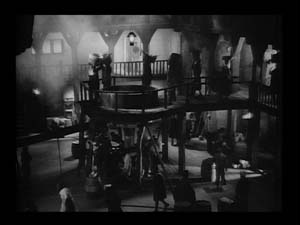
While White Zombie’s ethnophobic paradigm endured through many subsequent zombie films, its depiction of zombies was inevitably distorted over time. Dendle notes that the post-war zombie films marked an ambiguity to zombie ontology, blurring the voodoo zombie with drug-addled youth or Martian invaders (4). An intriguing example in this confusion of zombie identity is Ted V. Mikel’s camp film The Astro-Zombies (1968), released the same year as Night of the Living Dead. In The Astro-Zombies there are no real zombies at all, at least not by early or modern standards. The “astro-zombies” of mention are actually solar-powered cyborgs created by a mad scientist and capable of fairly sophisticated reasoning, such as when one cyborg’s energy source is destroyed and, in compensation, it uses a flashlight for power. These cybernetic golems bear little resemblance to the rotting, cannibalistic automatons that Romero pioneered that same year. The vast diversity of interpretations of this period suggest a radical simplification and lack of uniformity in the zombie mythos, facilitating Romero’s goal of revolutionizing the dominant perception of the zombie film. American cinemagoers of this era were completely unprepared for the graphic imagery and depressingly severe tone they would find in Night of the Living Dead.
Considering its reputation as the preeminent zombie film, it is surprising to find no trace of the term anywhere in the film. Instead, the living dead are referred to over radio broadcasts as ghouls, though the film’s protagonists never actually refer to them by any specific name. It is clear that, after 34 years of films using and obscuring the word “zombie,” it was not the concept of the Voodoo zombie which attracted Romero but rather the essence of the soulless living dead and the instinctive terror it draws from us. To this idea he added the cannibalism of the folkloric ghoul, as well as a scientific (though vague) explanation behind the reanimation of the dead. The strongest literary influence on Night was probably Richard Matheson’s novel I Am Legend, which Dendle concurs is “the ultimate inspiration for George Romero’s screenplay” (99). Though concerned with modern vampires, Legend adds the notion of infectious transmission to the creatures, and downplays the mystical aspect of zombification. Later movies would concentrate more on the biochemical cause of reanimation, but it is in the ambiguous reasoning of what exactly causes the dead to rise that Romero distinguishes his film from others in the genre. There is no Voodoo magic, no mad scientist, no hypnotic drugs to blame for the pandemic. All that is known is that when any person dies their body is exhumed by some unknown, primal force to unite unconsciously and feed on the living, who in turn rise to do the same.
The absence of a bokor or zombie controller drastically alters the source of fear from that of the malevolent “other” to the animalistic ghouls, who never once reveal any higher motive or intent other than one singular base desire: to kill and consume the living. Suggested to be the consequence of radiation brought back from Venus by a crashed satellite, the only suspected cause of transformation becomes entirely material, and therefore doesn’t coincide with any rational agenda or personal vendetta. Reanimation here is universal and everybody and anybody is susceptible to it. Consequentially, the zombies are not particularly exotic and are instead shadows of the regular small town denizens they once were -both familiar and yet utterly unfamiliar. The reason for the zombie phenomenon is unprejudiced and omnipresent, evoking an image of the biblical apocalypse or Judgment Day, or at least a bastardization of the “resurrection of the dead”. But if Judgment Day has indeed arrived in Night of the Living Dead, then the film judges not the immorality of the “other” like White Zombie, but the immorality in ourselves.
The self-reflexive moral criticism of Night of the Living Dead may very well be the residual influence of I Am Legend. The novel centers around the character of Robert Neville, the last man alive in the Los Angeles area following a viral epidemic which renders its victims into vampire-like abominations who rise at night to hound him from outside his barricaded home. Unlike other vampire stories, Legend does not focus so prominently on the conflict between the living and the undead as it does on the solitude and ennui that Neville must endure. Pulling himself out from a pit of alcoholism and purposelessness, Neville takes it upon himself to investigate the science underlying the vampiric disease in hopes of better understanding how to combat his antagonists. Experimenting with theories he derives from medical books and empirical knowledge he already possesses (aversion to garlic, vulnerability to sunlight), Neville goes about in the daylight in safety testing out new methods to kill the undead population. At the end of the book it is revealed that, though he believes himself to be ridding the world of the vampire scourge, he has actually inverted the vampire mythos. It is Neville who creeps about slaying the general population as they sleep, becoming “an invisible spectre who had left for evidence of his existence the bloodless bodies of their loved ones” (Matheson 159). I Am Legend does not tolerate the traditional view on the absolute equation of the good self and the evil other and instead embraces the relativity of evil. Throughout the majority of the book the reader sympathizes with Neville because they are able to identify with him -to find familiarity due to similarity of race. Yet in the end it is revealed that, though we have perceived the vampires as the “other” the entire time, “Normalcy [is] a majority concept” (159). The vampires, it turns out, perceive Neville as the suspicious “other,” as he very well is. In an ironic twist of logic, he has become the vampire legend to the vampires, and hence finds the familiar in himself to be likewise a reflection of the same unfamiliarity that he saw in the vampires.
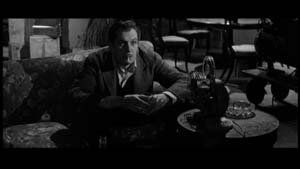
Released at the end of the 1960’s and halfway through the Vietnam War and in the midst of the Black Civil Rights movement, the self-reflexive moral critique of Night of the Living Dead must also have emanated from the social atmosphere of a nation divided in wartime. Unlike that of the unified home front of World War II, the social consciousness of mid 1960’s America was not wholly convinced of the righteousness of the violence perpetrated on foreign soil, due to the saturation of graphic images coming both from the battlefield as well as from the domestic home front. Countless lives were wasted on both sides of the battle, and footage of brutality committed by white Americans towards the black community revealed that Americans, like the communist “other,” were capable of unjustifiable cruelty. Violent retaliation by the police toward protesting youth also opened the population’s eyes to the cruelty unleashed upon the people that the war claimed to be serving. Moral absolutism was dissolving before them, and the utopic American dream was slowly turning into a nightmare. Much like Robert Neville and the flesh-eating ghouls who were once a law-abiding citizens, Americans were becoming aware of the malevolent “other” buried within them. Indeed, Bishop cites similarities between the protagonists and antagonists in Night, claiming that “Ben is almost as violent and irrational as the zombies themselves” (204). If the fear that anyone of the living protagonists could turn into the undead at any moment bread distrust among the refugees in that Pennsylvanian farmhouse, then that distrust was already present in homes all throughout the USA.
In the documentary The American Nightmare (Adam Simon, 2000), Tom Gunning offers his explanation for the horror felt at the sight of ghoulish cannibalism which distinguished Night from its contemporaries (10:50 – 11:20). In his view, cannibalism speaks to the tendency of parents to express their adoration for their children by playing at “eating them up,” and that this registers in the children a more literal interpretation that there is a fundamental desire in such gestures which does suggest a compulsion to eat their children. I would prefer a less psychologically oriented perspective in favour of a more ontological analysis. As highlighted earlier, death itself breeds fear in the idea of our own materiality. We fear the absence of spirit, the loss of the subjective identity which is the antecedent for all psychic processes. Just as we revile the zombie for existing as no more than cold matter driven by the most basic of drives, we dread the same thing in ourselves. By not only killing the spirit but consuming the flesh, the zombie makes it apparent to us that it perceives us much the same way that we perceive them: nothing more than a heap of flesh and fluid. Devouring us the way that we devour animals, the ghoul denies our cognition and reminds us that we are the same as any other animal or plant, no more and no less. Considering the gory photojournalism of soldiers killed gruesomely in the field of action and the endless conscripts fed into the war machine, Night of the Living Dead hit too close to home.
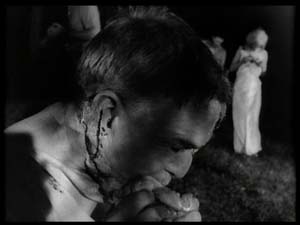
Here was a zombie film with a more subversive moral discourse than those which preceded it, more complex than the earlier propaganda films using zombies to symbolize the Red Scare or the dangers of drug use. Night of the Living Dead disregarded the cultural ignorance of the traditional zombie movie to make a more subtly introspective film -a masterpiece, as it has certainly been proclaimed. Dendle holds both Romero and Night in the highest esteem, asserting that “Romero is the Shakespeare of zombie film, and this is his Hamlet” (121). But I would disagree with Dendle’s analogy. Romero is certainly a cinematic master, the bokor of the modern zombie, but Night of the Living Dead’s reproach of American hubris and its blood-stained hands is more in tune with Macbeth than it is with Hamlet. It is hard to say whether or not Night is Romero’s true magnum opus, but if I were to compare any film in the dead series to the existential malaise rampant in Hamlet, I would have to pick Night’s sequel, Dawn of the Dead.
It took Romero eleven years to return to the zombie genre he had revived the decade before, and after more than ten years the social and cinematic landscape had changed dramatically. The Vietnam War had ended and Night had been a catalyst for the zombie subgenre, inspiring over 30 films across Europe and North America in less than a decade (Dendle 7). Still, Romero rekindled the originality which he had brought to the genre in order to confront the rise of vapid consumerism in suburban America. And so, as millions of citizens flooded out from their homes and into shopping complexes, Dawn likewise abandoned the rural farmhouse for the shelter of the Monroeville Mall.
Just as he had reconfigured the zombie identity in Night of the Living Dead, there is a distinct evolution in the way Dawn of the Dead portrays its undead chorus. Whereas Night was notable for its relentlessly bleak tone, Romero introduced an element of comedy into the ghouls of Dawn. The zombies remain the same lethargic, mindless, and cannibalistic fiends as established in the first Dead installment, but in the sequel their lack of higher reasoning permits Romero to toy with them like a child with a magnifying glass does to ants. A single zombie no longer forms such a prominent threat, as illustrated in scenes of Roger and Peter twirling and dodging through crowds of the living dead and shoving off those who lunge at them. Possibly the most absurd scene in the film is when Peter and Roger first go into the mall on a “hit-and-run” mission for resources, turning on all the power in the complex including the mall’s muzak, filling the place with light-hearted violin plucking and the occasional slide-whistle (40:02 – 40:27). The ensuing montage is anything but what one would expect to find in a horror film, showcasing zombies shambling about dopily, bumping into each other, falling over, and staggering on the escalator. It becomes hard to believe that these buffoons were the same monsters we had just seen tearing flesh from people’s necks and consuming human limbs. One cut in particular, where Romero juxtaposes an expressionless female mannequin’s head oscillating on a pedestal to a zombie nurse wandering aimlessly, reduces the humanoid aberration to the same innocuous material of the mannequin. Moreover, in the final scene, the orgiastic massacre of the undead by Blade and Sledge’s biker gang regresses into juvenile slapstick complete with seltzer water and pie throwing. Though the film is not without its moments of terror and gore, it is in these moments where Romero once again subverts the norm of incessant horror in the zombie film and elevates the genre once more.
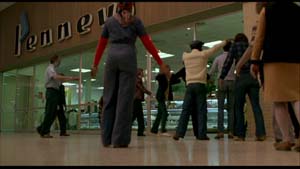
Dawn of the Dead is striking for these comedic interludes, but it is also significant for its lengthy fourth act following the group’s barricading of the entrances and slaughter of the remaining ghouls (1:26:30 – 1:50:09). The sequence endures for an astounding twenty-five minutes without a single zombie encounter, with the creatures serving primarily as a periphery menace rather than an immediate threat as in Night of the Living Dead. Safe and sound within the secured mall, the ensemble has total access to all the material goods the mall has to offer, and they certainly exploit it. They take a fortune’s worth of money from the bank, shop without hesitation, splurge on lavish dinners and clothing, and convert their storage room hideaway into what resembles an Ikea advertisement. However, the carefree oasis they create is an illusion, underscored by Roger’s degenerating physical state due to a bite wound sustained earlier.
It is no mystery that Romero’s zombies are allegorical in nature, and here they appear to represent the lifelessness inherent in vacuous consumerism. This metaphor becomes tangible when considering that zombies are exactly that: vacuous consumers of material (human flesh). Roger’s progressive deterioration into the undead is analogous to the group’s own moral deterioration. The editing of the sequence reveals this most forwardly, with Romero cutting from scene to scene of unburdened gaiety without concern for narrative progression or causality. Rather, each cut proceeds asynchronously through discontinuous spaces, presenting superficial images of enjoyment without any enduring quality, set to music which begins jubilantly and becomes increasingly disquieting. The brief scene in which Peter’s tennis ball bounces off the roof and into the parking lot below, revealing the horde of zombies which has amassed while the gang enjoyed their sanctuary from the ongoing zombie apocalypse, highlights the enduring presence of the living dead even in moments of safety. The ironic use of style in a horror film helps to distance the audience from the terrors of Dawn of the Dead’s universe and allows them to read into the malaise of modern life with these interruptions in tension without getting lost in pure visceral horror. In Dawn, as always with Romero’s zombie films, the focus is not on the undead who feed on humans but on the living death experienced by humanity, and Romero’s unconventional cinematic form is essential in doing so. After all, as Romero himself confirms, the titular living dead are actually “Us … We’re the living dead” (The American Nightmare 38:52 -39:03).
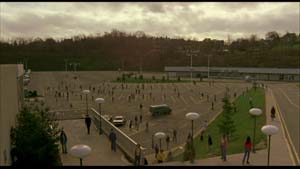
Through these two films and a third, Day of the Dead (1985), Romero managed to reignite the zombie horror film two separate times over the latter half of the twentieth century, and these elements of his individual style fossilized into the general anatomy of the modern zombie movie. Thirty years after the release of Night, one can still find apocalyptic premises, voracious cannibalism, bias toward scientific over mystical reanimation, and sardonic social metaphor in the descendants of the modern zombie genre. Looking at a film such as 28 Days Later (2002), whose massive success echoed Night’s revitalization of a genre waning into redundancy, one can see Romero’s impact resonates vibrantly.
Beginning in apocalyptic Britain and deconstructing a nuclear family in a claustrophobic manner, Boyle’s catalyst for the zombie genre seizes upon not only the narrative formula cemented in the Dead trilogy, but also on Romero’s methodology. Just as in Night of the Living Dead where the zombies bore little resemblance to their Voodoo ancestors, Boyle treats his creatures with the same unorthodoxy and disregard for tradition. The zombies conform to select similarities, such as their flesh-eating drive and battered exterior, but they stand apart on two distinctions: they are not the living dead, but humans consumed by a viral barbarism; and they do not shamble but run alarmingly quickly. By giving his zombies speed, Boyle marked a new stage in the evolution of the cinematic zombie. No longer the pathetic and sometimes comical drones of Dawn of the Dead, the “infected” in 28 Days Later pose a much more immediate and urgent threat. Likewise, the moral discourse of the film reflects a shift to the more immediate intimate aspects of morality on an interpersonal level.
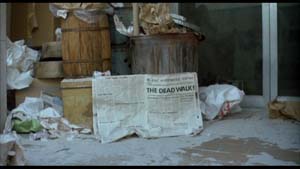
Other zombie films following 28 Days Later’s success, such as the remakes of Dawn of the Dead (2004) and Day of the Dead (2008), have made similar use of the rapid zombie, though without the same stress on sociopolitical satire. Boyle’s film, though faithful to the metaphorical structure Romero implemented, seems to have influenced most prominently the intensity of the zombies themselves, which has overshadowed their primarily allegorical foundation. By accelerating the rhythm of scenes between the living and the dead, the characters have no real time to reveal their ideologies and are instead downgraded to purely impulse based reaction. This shift in the structure of zombie horror signaled an departure from social satire to visceral intensity, with the zombies themselves taking the limelight from the humans who resist them. Because of the zombies’ physiological improvements, the threat of human individualism receded under the increased threat now posed by the undead. Romero’s shuffling ghouls were becoming a relic of an older age, replaced by more two dimensional speed demons hell-bent on devouring the living. But, as always for Romero, this new phase of zombie cinema was simply another convention to be undermined.
In an era of fast zombies, Romero’s most recent addition to the Dead trilogy (coming after the fourth installment, Land of the Dead, in 2005) Diary of the Dead (2007), stands apart from its contemporaries in its non-compliance with the fast zombie status quo. Returning to zero hour, or the initial onset of the zombie plague, Diary marks a return to form, raising the shambling zombies of Romero’s earlier films from near death. What is most compelling about Diary’s contempt for the recent zombie formula is that, by returning to the more traditional zombie, Romero is still destabilizing the modern conventions of what necessitates a good zombie film without disregarding the increased stress on immediacy of the undead threat. Just as Danny Boyle used the digital medium to endow his film with a documentary-like realism, Diary of the Dead advances this idea into the realm of reality horror employing a primarily subjective camera and re-establishing Night’s affinity for “everyday people in an ordinary landscape” (Bishop 203). By contextualizing the subjective camera within the narrative, Romero opens the medium to both self-reflexive criticism, as well as a sense of immediacy imparted through the medium’s proximity to reality, and not the zombie threat’s proximity to the characters.
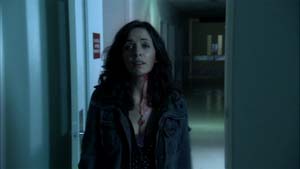
The story of Diary of the Dead is that of a film within a film, told from the first person perspective of the cameraman, Jason (Joshua Close), as well as through the voiceover of his girlfriend, Debra (Michelle Morgan). The dual subjectivity of the narrative voice facilitates Romero’s fusion of the distanciation inherent to Dawn of the Dead and the immediate reality favoured by more recent zombie movies. We are thrown into the reality of the image, understanding that it is intended to be raw and undoctored footage, and the minimal use of edits in a horror film appeals to Bazinian theory on the intensified realism afforded through the long take. However, the insertion of voiceover and source footage which divides each scene interrupts the flow of this realism, alternating captivating realism with distanced self-analysis. Moreover, the fact that the camera is literally from the viewpoint of the character(s), and that the voiceover directly addresses the audience rhetorically, evidences Romero’s primary concern for the intellectual and human elements in his films. Essentially, Diary of the Dead takes the same concerns for the zombie genre which underscored Night of the Living Dead and transposes them into a modern context dealing with issues of omnipresent media and intersubjectivity in place of expanded consciousness of our own violent nature.
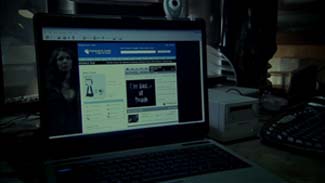
In conclusion, it may seem odd to consider a return to classical form as a subversion of any kind, but it is revelatory of George Romero’s authorship and its magnitude in the zombie subgenre. With his abhorrently graphic Night of the Living Dead, Romero laid unshakeable foundations for the zombie genre, which destabilized the presence of Voodoo mysticism in the conception of the zombie and offered a new form for ensuing zombie films. Night of the Living Dead formed the cornerstone of what we all perceive to be zombies, and Dawn of the Dead crystallized the satirical social discourse which its precursor had originated. Though his influence distorted and evolved over time, his intellectual approach and emphasis on more scientifically feasible conditions of reanimation resurfaced in Danny Boyle’s own reinvention of the genre. But, as with all innovations, the emergence of running zombies soon reverted to convention, lending the opportunity once more to oppose the normative and abide by a more personal vision of the zombie film. Even though it doesn’t entirely signal a new evolution in the zombie mythos, Diary of the Dead echoes Romero’s insuppressible originality and subversiveness toward zombie cinema which lies at the core of his work and continues to inspire and challenge conventions in the subgenre. Romero’s style has definitely come full circle, as Matheson might say.
Endnotes
1 The common Ancient Greek term for soul or “animating force” is psyche (ψυχή), however I am referring here to Nous in reference to Anaxagoras’ employment of the term as the active agent in animating the cosmos itself, and also to distinguish the mindful soul of the living from the uncanny psyche which persists in the living dead.
Work Cited
Bishop, Kyle. “Raising the Dead: Unearthing the Nonliterary Origins of Zombie Cinema”. Journal of Popular Film & Television 33.4 (2006): 196-205.
Dendle, Peter. The Zombie Movie Encyclopedia. Jefferson, NC: MacFarland & Company, Inc., 2001.
Matheson, Richard. I Am Legend. 1954. New York: Tom Doherty Associates, LLC., 2007.
Rhodes, Gary D. White Zombie: Anatomy of a Horror Film. Jefferson, NC: MacFarland & Company Inc., 2001.
The American Nightmare. Dir. Adam Simon. Perf. George Romero, Tom Gunning, John Carpenter, Wes Craven, Tobe Hooper. Minerva Pictures, 2000.


